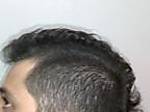Hi,
I want to dissolve the oil paint correctly for cockpit rib washes, should I place a blob of it on cardboard and have the oil drain away first before using it with thinners?
Not having odourless thinners but just white spirit, and branded thinners for Humbrol, Xtracolour and Phoenix Precision, (all enamels) and wishing to do shadow/accent washes along ribs and other parts in cockpit following spraying it matt RLM66, is it ok to use these and which would be best or would the Windsor and Newton odourless thinners behave better for oil paints, another trip back to the art shop if so ?
I have a nice matt finish from the paint. Doing the parts took many hours, and I dont want to have to gloss them for the wash then have to try and achieve their matt finish all over again. It took ages spraying into all the fine detail and structures and trying to get matt varnish in there I feel would see a variaton of sheens ! I havent yet found a decent matt varnish for my enamel paints ! I hope to touch the brush atop the rib and have the wash run along the structure to the corners. If thi doesnt work and perhaps wash will only run along the rib if its gloss, then it will be use of pigments and pastels to do so, at least the matt finish should give a good tooth for them. Matt varnish in my experience goes satin iof applied too thick, but trying to get back into the nooks and crannies with the matt varnish would see 'thick' happen.
Which thinner will allow the wash to stay close to the ribs and not stain the areas away from such. Keeping matt also enables me to use MIG pigments or pastels to do some highlighting of ribs, then follow up with crayons for scratches etc.
DBenz
Hosted by Jim Starkweather
Correct procedure for oil paint washes ?
DBenz

Joined: March 16, 2006
KitMaker: 6 posts
AeroScale: 2 posts

Posted: Sunday, February 28, 2010 - 10:36 AM UTC
Posted: Sunday, February 28, 2010 - 05:08 PM UTC
Hi DBenz,
The last time I used mineral (white) spirit with oils for a wash, it became gummy after 'drying'. I would make a wash from your enamels.
I recall others on this site have used oils for washes but I can't recall who. However, see this feature: Wash Techniques; it demonstrates oil with spirit, but also 'non-toxic' washes.
The last time I used mineral (white) spirit with oils for a wash, it became gummy after 'drying'. I would make a wash from your enamels.
I recall others on this site have used oils for washes but I can't recall who. However, see this feature: Wash Techniques; it demonstrates oil with spirit, but also 'non-toxic' washes.

chukw1

Joined: November 28, 2007
KitMaker: 817 posts
AeroScale: 729 posts

Posted: Monday, March 01, 2010 - 03:36 AM UTC
I use acrylics paints (Tamiya)- and I lay down a coat of acrylic clear gloss (Future). The gloss allows the thinned oil to flow evenly- a matte coat will cause blotching as the oils gets trapped in all the microscopic pockmarks that scatter reflected light to give the matte effect. I mix a thin brownish-black from my ancient art school tube colors with Humbrol thinners and flow it into the seams and around stuff I want to highlight. After it sets for 15 minutes or so I wipe off the excess with a soft rag just dampened in the thinners, working along the "airflow". You get some nice dirt effects this way. Wipe off too much? Reapply. After it's dried for a day or two, shoot on a flat coat to seal it in. Cheers- and best of luck!
chuk
chuk

Gendrok

Joined: July 21, 2010
KitMaker: 125 posts
AeroScale: 45 posts

Posted: Tuesday, July 23, 2013 - 07:08 PM UTC
I gotta revive rhis thread as I have a specific question on this. So I've seen a huge amount of videos regarding this on Youtube, and it looks very simple and straight forward.
1.Give your model a gloss coat
2.Get your tube of oil
3.Dilute the oil painting(I used Turpentine)
4.Apply and test in a small area
5. Give it 15-20min(I gave it 20)
6. Dampen a paper towel and rub off the wash.
Well it didn't work. No matter how much I dampened the paper towel the oil paint would not come off. It seemed the surface also ot sticky, and surely enough bits of paper towel clinged to the model.
I had to risk damaging the model, but after applying turpentine on it, and acting quickly I was able to clean up to a vey grimy F/A-18. Any idea what I'm failing on would help me improve
1.Give your model a gloss coat
2.Get your tube of oil
3.Dilute the oil painting(I used Turpentine)
4.Apply and test in a small area
5. Give it 15-20min(I gave it 20)
6. Dampen a paper towel and rub off the wash.
Well it didn't work. No matter how much I dampened the paper towel the oil paint would not come off. It seemed the surface also ot sticky, and surely enough bits of paper towel clinged to the model.
I had to risk damaging the model, but after applying turpentine on it, and acting quickly I was able to clean up to a vey grimy F/A-18. Any idea what I'm failing on would help me improve

robot_

Joined: March 08, 2009
KitMaker: 719 posts
AeroScale: 691 posts

Posted: Tuesday, July 23, 2013 - 07:56 PM UTC
Sounds like turpentine is a solvent for the dried paint. Use an odour-free oil thinner, e.g. Windsor and Newton
wychdoctor92394

Joined: July 07, 2013
KitMaker: 219 posts
AeroScale: 136 posts

Posted: Wednesday, July 24, 2013 - 04:34 AM UTC
I know this might sounds silly, but have you tried using Ronson lighter fluid as a thinner? It evaporates within minutes and leaves enamel paints completely matte; at least Humbrol and Testor enamels, but you might try on a scrap model to see if it works with oil paints...
It was a thought
Aside from the benefits/detractions as a thinner, it's cheap and you can always fill up your lighter with it, so it's not a total loss!
It was a thought

Aside from the benefits/detractions as a thinner, it's cheap and you can always fill up your lighter with it, so it's not a total loss!
Joel_W

Joined: December 04, 2010
KitMaker: 11,666 posts
AeroScale: 7,410 posts

Posted: Wednesday, July 24, 2013 - 08:35 AM UTC
I've been using oil and pin washes for several years with my armor models, and now with my aircraft models. Pin washes especially need a gloss surface to flow correctly. A matt finish won't let the wash flow smoothly and freely. I've been using Pledge/Future applied with a air brush without any issues. Not to confuse the issue, but for localized filters, I apply them over a matt/flat surface because I don't want them to run freely, nor do I want to remove to much of the filter.
I've used tube oils, and I've used Model Master enamel paints without issues. Both yield the same results for me. For diluting/thinning, I've always used plain old Mineral Spirits from the local hardware store. I thin both out 90% thinner:Paint, just eye balling it. With tube oils, I 1st place a small amount on a piece of cardboard so that the linseed oil can be drawn out of the oil paint. The more linseed oil, the longer drying time.
For mixing the wash I use a bottle cap. I even use the bottom of the larger Tamiya paint jars, and just wipe them clean when done.
Pin washes are applied with a #5/0 brush with the surface angled downward so that the wash flows in the direction I want. Where It stops I place another drop, and so on. I let the pin wash dry for about a 1/2 hour or so. Then using a Q-tip moistened with Mineral Spirits I rub the areas on both sides of the panel line, but not over it as it will wick up some of the wash from the recessed panel line . The longer your rub, the more of the wash will come off. Rotate the Q-tip so your wiping with a clean surface. If you continue to rub with a dirty surface, you're just re-applying the wash again. The surface has to be glossed to remove the max amount of excess wash. There is some small percentage of wash that you can't remove, but it's minor, and does add to the weathering process ever so slightly.
When you're done with applying all your washes/filters, you need to seal with a flat finish. Your choice is either acrylic or lacquer, but not mineral spirit based, as it will just react with your washes.
Joel
I've used tube oils, and I've used Model Master enamel paints without issues. Both yield the same results for me. For diluting/thinning, I've always used plain old Mineral Spirits from the local hardware store. I thin both out 90% thinner:Paint, just eye balling it. With tube oils, I 1st place a small amount on a piece of cardboard so that the linseed oil can be drawn out of the oil paint. The more linseed oil, the longer drying time.
For mixing the wash I use a bottle cap. I even use the bottom of the larger Tamiya paint jars, and just wipe them clean when done.
Pin washes are applied with a #5/0 brush with the surface angled downward so that the wash flows in the direction I want. Where It stops I place another drop, and so on. I let the pin wash dry for about a 1/2 hour or so. Then using a Q-tip moistened with Mineral Spirits I rub the areas on both sides of the panel line, but not over it as it will wick up some of the wash from the recessed panel line . The longer your rub, the more of the wash will come off. Rotate the Q-tip so your wiping with a clean surface. If you continue to rub with a dirty surface, you're just re-applying the wash again. The surface has to be glossed to remove the max amount of excess wash. There is some small percentage of wash that you can't remove, but it's minor, and does add to the weathering process ever so slightly.
When you're done with applying all your washes/filters, you need to seal with a flat finish. Your choice is either acrylic or lacquer, but not mineral spirit based, as it will just react with your washes.
Joel
 |











